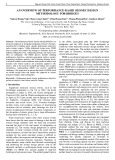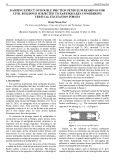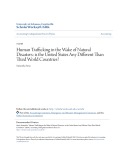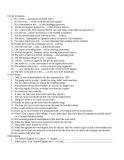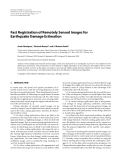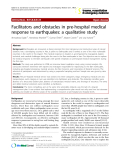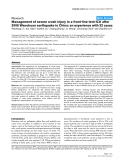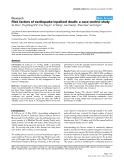
Earthquake
-
The Performance-Based Seismic Design (PBSD) is an advanced approach to designing earthquake-resistant structures, ensuring that a building meets specific performance objectives under seismic impacts. Unlike traditional design codes, PBSD aims to predict and control the damage to structures based on defined earthquake levels, minimizing damage and repair costs after an earthquake.
 7p
7p  vibenya
vibenya
 31-12-2024
31-12-2024
 4
4
 2
2
 Download
Download
-
The authors develop a system of differential equations describing the motion of the structural system equipped with DFP bearings. The Runge-Kutta numerical method, specifically the ode15s function in MATLAB, was used to solve these equations. The results of the calculations provide a comparison of the damping efficiency of the structural system with and without the use of DFP bearings, assessing the effectiveness of vibration isolation during an earthquake, with three components X, Y, and vertical considered.
 5p
5p  vibenya
vibenya
 31-12-2024
31-12-2024
 9
9
 2
2
 Download
Download
-
This research compares the impacts of devastating natural disasters on levels of human trafficking in developed countries to the impacts experienced in third world countries. The two disasters selected for this study were Hurricane Isaac in Louisiana and the Indian Ocean earthquake and tsunami in Indonesia. Factors selected to measure the impacts of the natural disaster include income level, homelessness, and unemployment rates.
 19p
19p  fugu897
fugu897
 03-07-2019
03-07-2019
 18
18
 1
1
 Download
Download
-
1. With my own ears I clearly heard the heart beat of the nuclear bomb. 2. Next year the bearded bear will bear a dear baby in the rear. 3. Early I searched through the earth for earthenware so as to research in earthquake. 4. I learn that learned earnest men earn much by learning. 5. She swears to wear the pearls that appear to be pears. 6. I nearly fear to tear the tearful girl's test paper. 7. The bold folk fold up the gold and hold it in hand. 8. The customers are accustomed to the disgusting custom....
 17p
17p  thanhtung911
thanhtung911
 17-08-2013
17-08-2013
 107
107
 33
33
 Download
Download
-
Word formation 1. He cycled…..and had an accident (care) 2. He was very …. of the work he had done (pride) 3. He is interested in the…. of old buildings (preserve) 4. All the newspapers praised the….of the firemen (brave) 5. An….pilot in the USA reported that he saw nine large round objects (experience) 6. Gas and oil….always increases in cold weather (consume) 7. We find advertising on the television very…..(effect) 8. The most….earthquake in Japanese history occured in 1923 (disaster) 9. For many employees, jod….is more important than making money (satisfy) 10.
 2p
2p  thaiminh8xpro
thaiminh8xpro
 09-03-2013
09-03-2013
 293
293
 37
37
 Download
Download
-
LOẠT CẢNH QUAY cũng khá giống với Chùm cảnh nhưng nó thường được diễn ra tại một địa điểm, nhắc tới một hành động. Hãy nhớ tới bộ phim Earthquake… MỘT LOẠT CẢNH A) Cửa sổ cửa hàng bắt đầu rung lắc. B) Các tấm biển đu đưa. C) Gạch và thuỷ tinh bắt đầu rơi xuống đường. D) Mọi người chạy thoát thân. LOẠT CẢNH được xác định là MỘT CẢNH. Giống như Chùm cảnh, loạt cảnh này là những khổ mô tả hành động và cũng có thể được đánh số 1), 2), 3) PHONG CÁCH Một vài biên kịch sẽ đưa một loạt các...
 4p
4p  bibocumi8
bibocumi8
 11-10-2012
11-10-2012
 101
101
 15
15
 Download
Download
-
Tuyển tập báo cáo các nghiên cứu khoa học quốc tế ngành hóa học dành cho các bạn yêu hóa học tham khảo đề tài: Fast Registration of Remotely Sensed Images for Earthquake Damage Estimation
 10p
10p  dauphong20
dauphong20
 10-03-2012
10-03-2012
 34
34
 5
5
 Download
Download
-
Tuyển tập báo cáo các nghiên cứu khoa học quốc tế ngành y học dành cho các bạn tham khảo đề tài: Attenuating posttraumatic distress with omega-3 polyunsaturated fatty acids among disaster medical assistance team members after the Great East Japan Earthquake: The APOP randomized controlled trial
 8p
8p  thulanh29
thulanh29
 17-12-2011
17-12-2011
 46
46
 4
4
 Download
Download
-
Tuyển tập các báo cáo nghiên cứu về y học được đăng trên tạp chí y học Critical Care giúp cho các bạn có thêm kiến thức về ngành y học đề tài: Earthquake-related versus non-earthquake-related injuries in spinal injury patients: differentiation with multidetector computed tomography...
 10p
10p  thulanh18
thulanh18
 05-11-2011
05-11-2011
 44
44
 5
5
 Download
Download
-
Tuyển tập các báo cáo nghiên cứu về y học được đăng trên tạp chí y học quốc tế cung cấp cho các bạn kiến thức về ngành y đề tài: "Facilitators and obstacles in pre-hospital medical response to earthquakes: a qualitative study
 9p
9p  toshiba18
toshiba18
 31-10-2011
31-10-2011
 74
74
 2
2
 Download
Download
-
Tuyển tập các báo cáo nghiên cứu về y học được đăng trên tạp chí y học Critical Care giúp cho các bạn có thêm kiến thức về ngành y học đề tài: Management of severe crush injury in a front-line tent ICU after 2008 Wenchuan earthquake in China: an experience with 32 cases...
 8p
8p  coxanh_6
coxanh_6
 29-10-2011
29-10-2011
 33
33
 1
1
 Download
Download
-
Tuyển tập các báo cáo nghiên cứu về y học được đăng trên tạp chí y học Critical Care giúp cho các bạn có thêm kiến thức về ngành y học đề tài: Risk factors of earthquake inpatient death: a case control study...
 6p
6p  thulanh18
thulanh18
 28-10-2011
28-10-2011
 31
31
 2
2
 Download
Download
-
Tuyển tập các báo cáo nghiên cứu về y học được đăng trên tạp chí y học General Psychiatry cung cấp cho các bạn kiến thức về ngành y đề tài: The World Trade Center Attack Similarities to the 1988 earthquake in Armenia: time to teach the public life-supporting first aid?
 3p
3p  thulanh16
thulanh16
 22-10-2011
22-10-2011
 48
48
 4
4
 Download
Download
-
The tallness of a building is relative and can not be defined in absolute terms either in relation to height or the number of stories. But, from a structural engineer's point of view the tall building or multi-storeyed building can be defined as one that, by virtue of its height, is affected by lateral forces due to wind or earthquake or both to an extent that they play an important role in the structural design. Tall structures have fascinated mankind from the beginning of civilisation.
 17p
17p  tranduyphung
tranduyphung
 24-08-2011
24-08-2011
 114
114
 14
14
 Download
Download
CHỦ ĐỀ BẠN MUỐN TÌM









